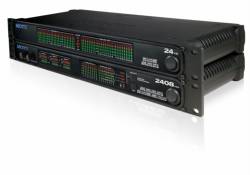
This year is all about more bandwidth for audio production, and one of the buzzwords you’re likely to hear a lot more of is PCI Express (PCIe). We’re only just now seeing cards that use the cutting-edge bus, but over the coming months they should become more commonplace. Granted, if you’re like me and focused on at-home music making, you probably spend most of your time using six or eight channels at a time, or, let’s face it, often just two! But for those who need 24 or 48 channels, even at high-resolution, more PCI performance is very good news. (Yes, this requires a breakout box, as pictured here — unless you had REALLY tiny audio jacks on the PCI card. Not really practical.)
Instead of stacking multiple cards, a single PCIe card can do everything you need, freeing up slots and reducing headaches. The bus is standard on Apple’s Power Mac G5 line and growing in popularity on desktop PCs.
PC/Mac audio interface maker MOTU today announced they’re shipping the PCIe-424, bringing their long-popular line of audio interfaces to the bus. Thankfully, they’re not stranding their existing customers: you’ll still be able to buy PCI-X cards if you have an older machine, or you can upgrade your old interface to PCIe if you’re ready to make the jump.
MOTU does an unusually good job of explaining what the new technology means without too much ad jargon. (Thanks for keeping the hype relatively low and the technical details clear, MOTU PR!)
MOTU isn’t alone, either; Digidesign announced PCIe versions of Pro Tools hardware in December. One key difference, however: you can mix and match a new PCIe MOTU card with your existing MOTU hardware “core system,” whereas Digi’s older HD hardware isn’t compatible with PCIe. There’s another caveat: Digidesign hasn’t yet qualified Windows PCs with PCIe because of the “lack of systems” with three slots. I expect this will change soon as new motherboards become more popular, but it’s worth noting. Like MOTU, Digidesign has trade-in / upgrade pricing to try to convince you to make the leap.
I’ll admit, I haven’t dealt with configuring PCI expansion systems since the days of the Power Mac G3. (Getting those expansion chassis from Digi to work back then was a real bear then, which I think has changed.) If this is your area, I’d love to hear your experiences. In the meantime, I subscribe as always to the “more is more” theory of bandwidth. In the long view, it does tend to bear fruit.